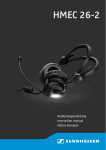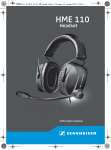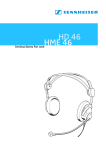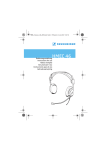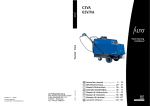Download Sennheiser HMD120 Technical data
Transcript
Instructions for use Headset HME 100 HME 105 HME 120 HMD 120 25 Contents Safety tips ...................................................................................................... 27 Headset features ................................................................................................ 28 Product variants ......................................................................................................... 29 Delivery includes ................................................................................................ 31 Preparing the headsets for use ........................................................................... 32 Connecting the headsets ............................................................................................ 32 Adjusting the headband ............................................................................................. 34 Positioning the microphone ........................................................................................ 35 Using the headsets ............................................................................................. 37 Mono/Stereo selection (HME 100 only) ...................................................................... 37 Adjusting the volume ................................................................................................. 37 Adjusting the microphone gain .................................................................................. 38 Folding up the headphones ........................................................................................ 38 Additional information for helicopter use of the HME 120 headset ........................... 39 Spare parts ......................................................................................................... 40 Replacing the wind screen .......................................................................................... 40 Replacing the ear cushions ......................................................................................... 40 Connector assignment ....................................................................................... 41 Troubleshooting ................................................................................................. 42 Technical data .................................................................................................... 44 26 The HME 100, HME 105, HME 120 and HMD 120 are pilot headsets with closed ear protector headphones for use in helicopters, propeller and turboprop aircraft. Safety tips • • • • When using a headset, typical aircraft sounds (for example, those from engines, propellers, warning alarms, etc.) may sound different to you. Before operating any aircraft, make sure that, while wearing a headset, you can hear and recognize these sounds. Set the volume to safe levels that do not interfere with your ability to hear informational sounds and warning alarms. Do not attempt to repair the headset yourself. If problems occur, contact your Sennheiser agent for assistance. Only replace parts of the headset whose replacement is described in this manual. All other parts of the headset must be replaced by your Sennheiser agent. Do not immerse the headset in water! For information on how to clean the headset, contact your Sennheiser agent. 27 Headset features HME 100 headset • • • • • • • • • 28 New passive headset with excellent noise attenuation Excellent comfort due to very low weight, soft ear cushions and padded headband as well as best possible freedom of movement due to unilateral connecting cable Foldable headband for easy and space-saving storage Clear communications due to MKE 45-1 electret microphone with adjustable sensitivity (sensitivity adjustment must be carried out by authorized personnel) Microphone can be easily positioned and worn on either left or right side due to flexible microphone boom with quick-fixing device Optimum radio reception due to headphone systems with wide frequency response Integrated volume control Adaption to the aircraft intercom system via Mono/Stereo switch Made in Germany, two-year warranty Product variants HME 105 headset The HME 105 differs from the HME 100 in the following features: • No Mono/Stereo switch • Connection of headphones and microphone via XLR-5 plug HME 120 headset The HME 120 differs from the HME 100 in the following features: • No Mono/Stereo switch • Coiled cable • Connection of headphones and microphone via U-174/U jack plug to a high impedance interface in the helicopter 29 HMD 120 headset The HMD 120 differs from the HME 100 in the following features: • No Mono/Stereo switch • Coiled cable • M-87/AIC dynamic microphone and low impedance headphones • Connection of headphones and microphone via U-174/U jack plug to a low impedance interface in the helicopter 30 Delivery includes HME 100, HME 105 and HME 120 headsets • • • • Headset Padded carry and storage bag with shoulder strap for headset and accessories Wind screen for microphone Cable clip MZQ 2002-1 (Cat. No. 4470) HMD 120 headset • • • Headset Padded carry and storage bag with shoulder strap for headset and accessories Cable clip MZQ 2002-1 (Cat. No. 4470) Recommended Accessories • Replaceable gel ear cushions (Cat. No. 83140) 31 Preparing the headsets for use Connecting the headsets HME 100 headset: 1 1 Connecting cable for HME 100 씰 1 /4” (6.35 mm) stereo jack plug for connecting the headphones PJ-068 jack plug for connecting the microphone Connect the 1/4” (6.35 mm) stereo jack plug for the headphones and the PJ-068 jack plug for the microphone to the corresponding jack sockets of your intercom. HME 105 headset: 1 씰 Connecting cable for HME 105 32 XLR-5 plug for connecting the headphones and the microphone Connect the XLR-5 plug for the headphones and the microphone to the XLR-5 socket of your intercom. HME 120 and HMD 120 headsets: 1 씰 U-174/U jack plug for connecting the headphones and the microphone Connect the U-174/U jack plug for the headphones and the microphone to the U-174/U socket of your intercom. Connecting cable for HME 120 and HMD 120 33 Adjusting the headband For good noise attenuation and best possible comfort, the headband has to be adjusted to properly fit your head: 씰 Wear the headset so that the headband runs over the top of your head. 씰 Adjust the length of the headband so that • your ears are completely inside the ear cushions, • you feel even, gentle pressure around your ears, • a snug fit is ensured. Note: Make sure not to squeeze any connecting cable when adjusting the headband. Squeezing can damage the connecting cables. 씰 34 Final adjustment is best made in a noisy environment. Positioning the microphone Relocating the microphone boom The microphone boom can be worn on either side of the mouth. 씰 Loosen the quick-fixing device. 씰 Rotate the microphone boom by 180°. 씰 Tighten the quick-fixing device. Positioning the microphone towards the corner of the mouth The HME 100, HME 105 and HME 120 headsets feature a flexible microphone boom. Bend the microphone boom so that the microphone is placed at the corner of the mouth. Maintain a distance of approx. 2 cm between microphone and mouth. 35 For positioning the microphone of the HMD 120 headset, proceed as follows: 씰 Adjust the length of the microphone boom so that the microphone is placed at the corner of the mouth. To do so, loosen the quick-fixing device and adjust the microphone boom in length. 씰 Pull the middle part of the microphone boom towards the mouth so that the distance between microphone and mouth is approx. 2 cm. 씰 Tilt the microphone for final positioning. 36 Using the headsets Mono/Stereo selection (HME 100 only) In general, you‘ll receive a mono sound source so that the Mono/Stereo switch can remain set to ‘Mono’. When using a stereo intercom system, set the headset to stereo operation. Remove the ear cushion (쏅 ‘Replacing the ear cushions’) from the earcup with the microphone boom attached and set the Mono/Stereo switch to ‘Stereo’. Adjusting the volume Exposure to loud sounds can cause hearing damage! Set the volume control to a medium value. Make sure that you can hear critical sounds such as warning alarms. 37 Adjusting the microphone gain Mic Gain Adjustment According to JTSO approval C58a, the microphone output voltage is factory-preset to 400 mV. If the microphone output voltage is too high or too low for your intercom system, it can be re-adjusted on the microphone. To do so, use a small slotted screwdriver and turn the ‘Mic Gain Adjustment’ screw (see illustration on the left) until you have reached the desired setting. Folding up the headphones For easy and space-saving transportation, the earcups can be folded up and tucked between the headband. Unfold the headphones by grasping both earcups and pulling them down and away from the headband. 38 Additional information for helicopter use of the HME 120 headset The polarity of the microphone connection in helicopters is not standardized. If the microphone of your headset does not work with the existing polarity, you can reverse the polarity on the headset by simply rotating the microphone module. To do so, please proceed as follows: 1. Pull the wind screen from the microphone. 2. Loosen the screws by approx. half a turn. 3. Pull the microphone module from the boom-arm. 4. Rotate the microphone module by 180°. 5. Put the rotated microphone module back into the boom-arm. 6. Now tighten the screws from the other side. 7. Slide the windscreen over the microphone. Rotating the microphone module does not change its acoustic properties. Due to its noisecompensating pick-up pattern, the microphone can be used from either side. 39 Spare parts The following spare parts are available from your Sennheiser agent: • Wind screen for MKE 45-1 electret microphone • Cable clip • Carry and storage bag with shoulder strap • Ear cushions Replacing the wind screen If the wind screen for the electret microphone shows signs of wear such as tears or holes, replace the wind screen. Pull the wind screen from the microphone. Gently slide-on the new wind screen and ensure that it fits securely over the microphone. Replacing the ear cushions Replace the ear cushions if they are damaged. Grasp behind the ear cushions and pull them up and away from the earcups. Slide the new ear cushions onto the earcups. For best results replace the ear cushions after 100 hours of use or two years. 40 Connector assignment ; ;;;;;;;;;;;;; 2 1 3 4 5 ;;;;;;;;;;;;; solder side 1 2 3 4; U174/U jack plug XLR-5 connector 1 2 3 4 1 2 3 4 5 1 1 Microphone Lo Audio Hi Microphone Hi Audio Lo 2 3 /4” (6.35 mm) stereo jack plug 1 2 3 Audio Hi left Audio Hi right Audio Lo 1 Audio Hi Audio Lo Microphone Hi Microphone Lo — 2 3 PJ-068 jack plug 1 2 3 Not assigned! Microphone Hi Microphone Lo 41 In case of difficulty If problems occur that are not listed in the below table, please contact your Sennheiser agent. Problem Possible cause and what to do Communications in one ear only (HME 100 only) You are using a stereo intercom system but the headset is set to mono operation. 씰 Set the Mono/Stereo switch to ‘Stereo’. You are receiving a mono source but the headset is set to stereo operation. 씰 Set the Mono/Stereo switch to ‘Mono’. Very low volume communication The volume control is set too low. 씰 Check the volume setting of the headset. The headphone connection has been pulled out. 씰 Check to see if the headphone jack plug is correctly connected. Reduced intelligibility 42 The microphone connection has been pulled out. 씰 Check to see if the microphone jack plug is correctly connected. Problem Possible cause and what to do Microphone output voltage too high or too low Re-adjust the output voltage on the microphone. 씰 To do so, use a small slotted screwdriver and turn the ‘Mic Gain Adjustment’ screw (see illustration on page 38) until you have reached the desired setting. 43 Technical data HME 100 HME 105 and HME 120 HMD 120 150 Ω, mono 16 Ω, mono electret mic capsule, noise-compensated MKE 45-1 300–5,000 Hz – 120 dB 150 Ω 400 mV ± 3dB at 114 dB (as per RTCA/DO 214) dynamic, noise-compensated M-87/AIC 500–4,000 Hz 1.8–4 µV/74 dB bei 5 Ω – – – Headphones Transducer principle Ear coupling Frequency response Nominal impedance Attenuation Contact pressure dynamic circumaural, closed 45–15,000 Hz 150 Ω, mono, 300 Ω, stereo > 10–40 dB approx. 10 N Microphone incl. preamplifier Transducer principle Frequency response Sensitivity Max. sound pressure level Min. terminating impedance Output voltage 44 electret mic capsule, noise-compensated MKE 45-1 300–5,000 Hz – 120 dB 150 Ω 400 mV ± 3dB at 114 dB (as per RTCA/DO 214) Supply voltage HME 100 HME 105 HME 120 HMD 120 typ. 16 V DC (8–16 V DC, approx. 8–25 mA as per RTCA/DO 214) typ. 16 V DC (8–16 V DC, approx. 8–25 mA as per RTCA/DO 214) typ. 16 V DC (8–16 V DC, approx. 8–25 mA as per RTCA/DO 214) – General Data Connecting cable Weight without cable Connectors Controls Temperature range 1.5 m, unilateral 350 g 6.35 mm stereo jack plug for headphones, PJ-068 jack plug for microphone Mono/Stereo switch Volume control for headphones Operation Storage coiled cable, unilateral XLR-5 for headphones and microphone – U-174/U jack plug for headphones and microphone – U-174/U jack plug for headphones and microphone – -15°C ... + 55°C -55°C ... + 55°C 45 Certificate of Conformity Sennheiser electronic GmbH & Co. KG declare that this device conforms to the applicable CE standards and regulations. For up-to-date information on Sennheiser products, you can also visit the Sennheiser Web site at “http://www.sennheiser.com”. 46 Sennheiser electronic GmbH & Co. KG D-30900 Wedemark Telefon 05130/600-0 Telefax 05130/600-300 Printed in Germany Publ. 01/03 136 83566 / A02























